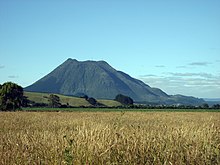|
Ngāti Awa37°57′18″S 176°59′35″E / 37.955°S 176.993°E
Ngāti Awa is a Māori iwi (tribe) centred in the eastern Bay of Plenty Region of New Zealand. It is made of 22 hapū (subtribes), with 15,258 people claiming affiliation to the iwi in 2006.[1] The Ngāti Awa people are primarily located in towns on the Rangitaiki Plain, including Whakatāne, Kawerau, Edgecumbe, Te Teko and Matatā.[2] Two urban hapū also exist in Auckland (Ngāti Awa-ki-Tamaki) and Wellington (Ngāti Awa-ki-Poneke).[3] History Early historyNgāti Awa traces its origins to the arrival of Māori settlers on the Mātaatua waka (canoe). The Mātaatua settlers established settlements in the Bay of Plenty and Northland. Initially, the tribe controlled a large area in Northland, but conflicts with other northern iwi resulted in a southward migration. One group eventually settled in the eastern Bay of Plenty, whose descendants would eventually found the iwi. Awanuiarangi II is recognised as the eponymous ancestor of Ngāti Awa. Awanuiarangi II was a chief descended from Toroa, captain of the Mātaatua. Descendants of Awanuiarangi II eventually formed their own iwi, Ngāti Awa, named after their ancestor.[2] Tribal and land warsNgāti Awa was frequently at war with neighbouring iwi, including those with similar ancestry. Ngāti Awa initially had good trading relations with European settlers. However, the New Zealand Wars of the 1860s resulted in the British Crown confiscating more than 1,000 km2 of Ngāti Awa land. For more than a century afterwards, Ngāti Awa remained an aggrieved, struggling people. However, in 1999, the Waitangi Tribunal determined that the confiscation of Ngāti Awa land in the New Zealand Wars by the British Crown was illegal, and in 2003 a settlement was reached between Ngāti Awa and the New Zealand Government. In the nineteenth century Ngāti Pūkeko were considered a separate iwi, but they are currently considered a hapū of Ngāti Awa.[2] Government settlementIn 2003, following almost ten years of negotiations between the New Zealand Government and Ngāti Awa, a settlement was announced and reparations were made to the iwi. In summary:
On settlement the Ngāti Awa Research Centre that was established in 1989 to generate research for the Waitangi Tribunal claim became Ngāti Awa Research and Archives.[4][5] Hapū and maraeWhakatāne hapūThe following hapū are based around Whakatāne and Coastlands:
Poroporo hapūThe following hapū are based around Poroporo and Paroa:
Te Teko hapūThe following hapū are based around Te Teko and Edgecumbe:
Matatā and Motiti hapūThe following hapū are based around Matatā and on Mōtītī Island:
Urban hapūThe following urban hapū are affiliated with Ngāti Awa:
GovernanceTe Rūnanga o Ngāti AwaTe Rūnanga o Ngāti Awa became the new governing body of the iwi in 2005.[2] Representatives from the Rūnanga were responsible for negotiating the settlement with the government on behalf of Ngāti Awa. Based in Whakatāne, the rūnanga manages the financial assets of the iwi, and promotes cultural, educational and economic development in the region.[6] The trust manages the tribe's Treaty of Waitangi settlement under the Ngāti Awa Claims Settlement Act and is a body corporate for the tribe's land, under Te Runanga o Ngāti Awa Act. It represents the iwi in aquaculture and fisheries under the Māori Commercial Aquaculture Claims Settlement Act, and represents the iwi during resource consent consultation under the Resource Management Act. The trust is governed by one representative from each of the 22 hapū, and is based in Whakatāne.[3] Local governmentThe tribal area of the iwi is within the territory of Kawerau District Council and Whakatāne District Council. It is also within the wider territory of the Bay of Plenty Regional Council.[3] MediaSun FMSun FM is the radio station for Ngāti Awa. It was first known as Te Reo Irirangi o Te Manuka Tutāhi during a three-week AM trial run in 1990. It went to air as Tumeke FM on 6 April 1991, became Sun FM in 1994 to increase its advertising appeal, and between 1996 and 1999 worked to increase its Māori language content.[7] The classic hits station broadcasts on 106.5 FM in Whakatāne.[8] Notable people
See alsoReferences
Information related to Ngāti Awa |
||||||||||||||
Portal di Ensiklopedia Dunia

